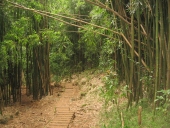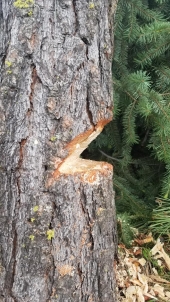
 1
1








A) Tropical- hot and humid, average temperatures are greater than 64°F (18°C) year-round and there is more than 59 inches of precipitation each year
B) Dry- dry (not humid) and little precipitation
C) Temperate- warm and humid summers with thunderstorms and mild winters
D) Continental- warm to cool summers and very cold winters. In the winter, this zone can experience snowstorms, strong winds, and very cold temperatures—sometimes falling below -22°F (-30°C)!



 3
3




Other people may reject you but if you lie in the forest floor for long enough the moss and fungi will accept you as one of their own!
 2
2




 4
4




(we do often get a month where the average is -4 or so)Oceanic climates are defined as having a monthly mean temperature below 22 °C (72 °F) in the warmest month, and above 0 °C (32 °F) (or −3 °C (27 °F)) in the coldest month.


 2
2




 2
2




Argue for your limitations and they are yours forever.
 3
3




Work, thought, muck




Dennis Bangham wrote:I am in Zone 7b in North Alabama (aka Rocket City). I find that Jujube, Asian Pear, Asian Persimmon, Pawpaw, Raspberries and blackberries grow well here.

I will soon wood chip my backyard and see what else I can get to grow between the trees. Any ideas/suggestions?
I also grow mushrooms on logs. The warm and hot varieties grow well but are usually consumed by bugs. The Cool and Cold weather varieties (Shiitake, Oyster) are wonderful and no bugs.
Striving to grow things as naturally, simply, and cheaply as possible! 
My YouTube channel




Lucca Wade wrote:I’m near Charlotte, NC, and strawberries and raspberries seem to be the most fruitful.

Striving to grow things as naturally, simply, and cheaply as possible! 
My YouTube channel




Skandi Rogers wrote:North West Denmark, Oceanic climate 7b
(we do often get a month where the average is -4 or so)Oceanic climates are defined as having a monthly mean temperature below 22 °C (72 °F) in the warmest month, and above 0 °C (32 °F) (or −3 °C (27 °F)) in the coldest month.
Trees
Apples
Plums
Quince
Pears
Cherries
Elder
Hawthorn
Rowen
Bushes
Sea buckthorn
Red/black/white currants
Gooseberries
Blackberries
Raspberries

Striving to grow things as naturally, simply, and cheaply as possible! 
My YouTube channel




Sandy Golden wrote:Blueberries, especially the rabbit eye variety, do really well throughout Georgia. They like really acid soil (4.5-5.0).

Striving to grow things as naturally, simply, and cheaply as possible! 
My YouTube channel




Mike Barkley wrote:I'm 7a or 7b depending on the source & to a certain extent altitude. Blackberries, raspberries, & blueberries grow wild here. Especially blackberries. Persimmons are abundant in the wild too. There are commercial apples & peach orchards around. Elderberry does great. Still struggling with figs but it is possible to keep them alive around here. Some people grow strawberries but I haven't tried growing them here yet. Intend to start a patch of those this spring if time permits. Watermelons & melons in general thrive here with a bit of soil amendment first. A friend planted some plum trees 2 years ago. No fruit yet but they appear to be doing good.


Striving to grow things as naturally, simply, and cheaply as possible! 
My YouTube channel




Andy Youngblood wrote:I'm in SW Arkansas zone 7b. Continually adding, but here are most of the things we currently have in the forest garden. Some are young and have not fruited yet, but I believe all will.
Fig (a few varieties. all die back to the root each winter unprotected), peach, european and asian pears, plum, apple, crabapple, blueberries, blackberries, raspberries, gooseberries, elderberries, gojiberries, aronia berries, paw paw, hayhaw, muscadines, mulberry, apricot, nectarine, goumi, jujube, hazelnut, chestnut, black walnut, pecan

Striving to grow things as naturally, simply, and cheaply as possible! 
My YouTube channel
 2
2




"Disturbance is critical" Joel Salatin
 3
3








Jan Hrbek wrote:Temperate/Continental, 300 m (985 ft) a.s. l., 9°C (48 F) average year temp., 500-550 mm (20-22 inch) of rain/year. 30-35°C (90-95 F) in summer..
Peach, apricote, almond tree, mullberry, vine, figs (hardy varieties)
plum, cherry, sour cherry, apple, pear, quince, Sorbus, medlar..
wallnut, chesnut
almost all kinds of berries..

Striving to grow things as naturally, simply, and cheaply as possible! 
My YouTube channel




Kevin Goheen wrote:Of things growing naturally or introduced in Western Kentucky Zone 7a (Heavy clay is our soil type)we have:
Black cherries
Pawpaws
Blackberries
Grapes
Black walnuts
Pecans
Hickories
American plum
Chickasaw plum
American persimmon
Japanese Wineberries
Black Raspberries
Hazelnuts
Mulberries
Paper Mulberries
Sumacs
Elderberry
Wild Passionfruit (Maypop)
And my absolute favorite: Autumn Olive <3
Generally the best success we have had have been:
Blueberries
Grapes
Muscadine Grape
Figs (Rough winters may suffer die back, but one grew 9 ft this past year!)
Blackberries
Boysenberries
Pears
Asian Pears
Mulberries
Black Walnuts
Hardy Banana (About 15-30 days too short a growing season to ripen fully, but a cold frame in the early Spring might help)
Anna and Meader Kiwi (Not Issai)
Red Raspberries in tailored conditions
Plums grow great, but bud early (Have some trying to flower right now)
Bush cherries (Sand and Nanking)
Also the reason why apples and peaches are much more iffy in my area is that most nurseries sell them in rootstocks bred for a loam soil. So in our very wet winters and springs, they rot or struggle. Digging out a much larger hole and replacing it with loam, compost, and a portion of the normal soil helps a LOT, but getting them on the correct rootstock is best. For our area apples should be on G22, G202, and M111. For peaches I am hoping to try grafting them onto Chickasaw plums this year. This maybe the same issue that regular cherry trees suffer here as the only cherries that grow well locally are sand, nanking, black, and ornamentals.

Striving to grow things as naturally, simply, and cheaply as possible! 
My YouTube channel
 3
3




 Thanks ya'll.
Thanks ya'll.
 1
1




Sena Kassim wrote:Sooo it's been a minute since someone posted. I am new to our area and the list is very helpful for planning our homestead.
Thanks ya'll.
Wildly growing we have...
Black Rasberry
Black Walnuts
Chestnut
our neighbor has persimmons, we'd like to have some too
Apples
We have added
Apples
Blueberries
A ton of strawberries (we get both of these from our county extension office bare root fruit sale)
Tomatoes do really well for us
Elderberries
We plan to add more fruit trees. I really want to try figs. We are zone 7b surrounded by zone 6. Sometimes the summer is hot and dry and the spring wet and cool.
I have lots of varieties if you want cuttings or whole trees. I’m right up the road from you.
Pioneer Plants Permaculture

|
You frighten me terribly. I would like to go home now. Here, take this tiny ad:
Play Your Way to a Sustainable Lifestyle: Uncover Permaculture Principles with Each Card
https://gardener-gift.com/
|









